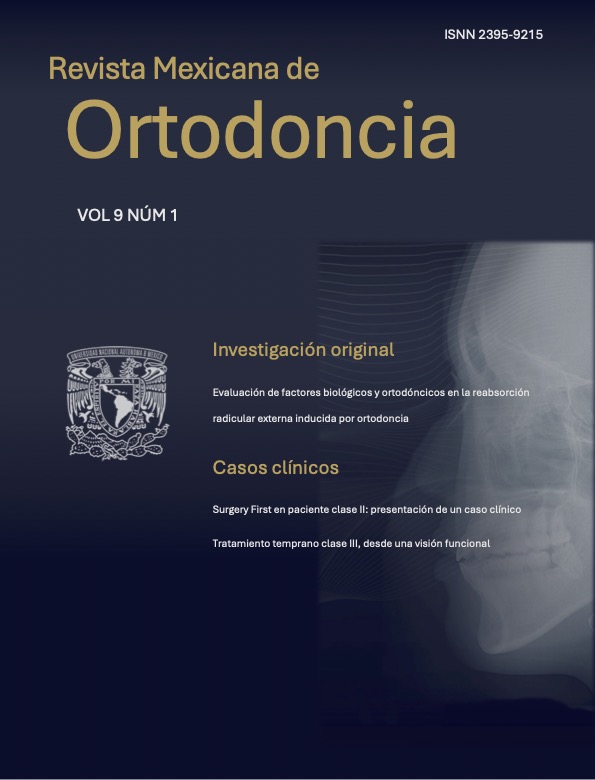Early Class III Treatment, from a Functional Point of View
Main Article Content
Abstract
Introduction: A simple therapy is shown for the interception of class III malocclusion at an early age, emphasizing the importance of swallowing and breathing for adequate maxillary development, returning to the biological bases of occlusal and skeletal development. Objective: To identify dental or bone disharmonies during development, based on knowledge of what is normal, knowing how to identify alterations early, to intercept and not allow a more serious malocclusion to develop. Case presentation: Two clinical cases are shown, both class III dental and with respiratory problems, the first in a six-year-old girl, and the second detected at three years of age, they are referred and treated by the otorhinolaryngologist, to treat the etiological factor, the correction of the airway, orthodontic treatment focused on achieving an adequate relationship of the incisal guide of the permanent dentition, so that once the respiratory and oral function is corrected, development occurs adequately, every six months radiographic monitoring to evaluate changes and make therapeutic decisions until twelve and fifteen years of age respectively, occlusal stability continues to be monitored without any unfavorable changes at the moment. Conclusions: Detecting alterations in growth and development at an early age helps to intercept both dental and bone malocclusions, knowledge of basic sciences helps the clinician in making timely decisions during the patient's growth, and with simple treatments can avoid unnecessary treatments more invasive.
Article Details
References
Beata K, Antoszewska J, Necka A. Genetics or environment? A Twin-Method Study of Malocclusions. World J Orthod. 2007; 8(4): 405–10.
Zere E, Chaudhari PK, Sharan J, Dhingra K, Tiwari N. Developing Class III Malocclusions: Challenges and Solutions. Clin Cosmet Investig Dent. 2018; 10: 99–116. DOI: 10.2147/CCIDE.S134303
Flores YL, Fernández VMA, Heredia PE. Valores cefalométricos craneofaciales en niños preescolares del Jardín de Niños CENDI UNAM. Rev Odont Mex. 2004; 8(1-2): 17–23. DOI: 10.22201/fo.1870199xp.2004.8.1-2.16274
Park JU, Baik SH. Classification of Angle Class III Malocclusion and its Treatment Modalities. Int J Adult Orthodon Orthognath Surg. 2001; 16(1): 19–29.
Nienkemper M, Wilmes B, Pauls A, Drescher D. Maxillary Protraction Using a Hybrid Hyrax-Facemask Combination. Prog Orthod. 2013; 14(1): 5. DOI: 10.1186/2196-1042-14-5
Hardy DK, Cubas YP, Orellana MF. Prevalence of Angle Class III Malocclusion: A Systematic Review and Meta-Analysis. Open J Epidemiol. 2012; 2(4): 75–82. DOI: 10.4236/ojepi.2012.24012
Stocker B, Willmann JH, Wilmes B, Vasudavan S, Drescher D. Wear-Time Recording during Early Class III Facemask Treatment Using Theramon Chip Technology. Am J Orthod Dentofacial Orthop. 2016; 150(3): 533–40. DOI: 10.1016/j.ajodo.2016.04.016
Heymann GC, Cevidanes L, Cornelis M, De Clerck HJ, Tulloch JF. Three-Dimensional Analysis of Maxillary Protraction with Intermaxillary Elastics to Miniplates. Am J Orthod Dentofacial Orthop. 2010; 137(2): 274–84. DOI: 10.1016/j.ajodo.2009.07.009
Woon SC, Thiruvenkatachari B. Early Orthodontic Treatment for Class III Malocclusion: A Systematic Review and Meta-Analysis. Am J Orthod Dentofacial Orthop. 2017; 151(1): 28–52. DOI: 10.1016/j.ajodo.2016.07.017
Linder-Aronson S, Woodside DG, Lundström A. Mandibular Growth Direction Following Adenoidectomy. Am J Orthod. 1986; 89(4): 273–84. DOI: 10.1016/0002-9416(86)90049-7
Bianchini AP, Guedes ZC, Vieira MM. A Study on the Relationship Between Mouth Breathing and Facial Morphological Pattern. Braz J Otorhinolaryngol. 2007; 73(4): 500–5. DOI: 10.1016/s1808-8694(15)30101-4
Tomer BS, Harvold EP. Primate Experiments on Mandibular Growth Direction. Am J Orthod. 1982; 82(2): 114–9. DOI: 10.1016/0002-9416(82)90490-0
Torre C, Guilleminault C. Establishment of Nasal Breathing Should Be the Ultimate Goal to Secure Adequate Craniofacial and Airway Development in Children. J Pediatr (Rio J). 2018; 94(2): 101–3. DOI: 10.1016/j.jped.2017.08.002
Peltomȁki T. The Effect of Mode of Breathing on Craniofacial Growth–Revisited. Eur J Orthod. 2007; 29(5): 426–9. DOI: 10.1093/ejo/cjm055
Woodside DG, Linder-Aronson S, Lundstrom A, Mcwilliam J. Mandibular and Maxillary Growth After Changed Mode of Breathing. Am J Orthod Dentofacial Orthop. 1991; 100(1): 1–18. DOI: 10.1016/0889-5406(91)70044-W
Fu Z, Lin Y, Ma L, Li W. Effects of Maxillary Protraction Therapy on the Pharyngeal Airway in Patients with Repaired Unilateral Cleft Lip and Palate: A 3-Dimensional Computed Tomographic Study. Am J Orthod Dentofacial Orthop. 2016; 149(5): 673–82. DOI: 10.1016/j.ajodo.2015.10.024
Enlow DH, Moyers RE, Hunter WS, McNamara JA Jr. A Procedure for the Analysis of Intrinsic Facial Form and Growth. An Equivalent-Balance Concept. Am J Orthod. 1969; 56(1): 6–23. DOI: 10.1016/0002-9416(69)90254-1
McNamara JA, Brudon W, De Montes A. Tratamiento ortodóncico y ortopédico en la dentición mixta. Estados Unidos: Needham Press; 1995.
